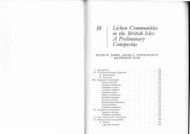You also want an ePaper? Increase the reach of your titles
YUMPU automatically turns print PDFs into web optimized ePapers that Google loves.
In submontane and montane, usually rather high<br />
precipitation, oceanic sites on rain protected<br />
over-hanging surfaces on (<strong>of</strong>ten hard) silicate<br />
rock on (r.-)v.humid, m.(-r) lighted habitats,<br />
usually in m.cool, foggy valleys, parasitic on<br />
crustose lichens, above all Haematomma ochr.,<br />
m.-r.acidoph., anombroph., m.thermoph.,<br />
anitroph., char. Lecanoretum orosth. – s’bormed-mo,<br />
oc – v.rare (R); süSch, O (Heidelb.),<br />
PfW, Ts, ? Vgb, Sp<br />
Calicium glaucellum Ach.<br />
Up into the high montane zone on rain protected<br />
trunk surfaces <strong>of</strong> older deciduous and conifer<br />
trees, on r.-v.acid bark (usually in bark cracks <strong>of</strong><br />
oak and conifer tree bark), also on ± hard, tough<br />
decayed to rather decayed wood <strong>of</strong> debarked tree<br />
trunks on, in lower sites usually on old oak in<br />
humid valleys and forests (oak-hornbeam and<br />
oak-beech forests), on higher sites also on windy<br />
habitats, r.-v.acidoph., r.skioph. -r.photoph.,<br />
anombroph. -r.anombroph., anitroph., char.<br />
Calicion vir., in lower sites usually with C.<br />
salicinum, on higher sites <strong>of</strong>ten with C.<br />
trabinellum, above all in the Calicietum glauc.,<br />
Xylographetum vit. – bor-med-mo – r.rare (3);<br />
above all in the mountains, in the hilly zone<br />
v.rare to lacking and regressing because <strong>of</strong><br />
eutrophication <strong>of</strong> the habitats<br />
Calicium lenticulare Ach. (C. subquercinum<br />
Asah., C. amylocaule Lettau, C. schaereri auct.)<br />
In the montane and high montane, high<br />
precipitation sites on rather decayed, rotting<br />
wood <strong>of</strong> debarked stumps and trunks (usually<br />
basal) above all <strong>of</strong> conifers, rare on conifer bark,<br />
on usually rather shady, very humid, rain<br />
sheltered small habitats, r.-v.acidoph.,<br />
m.substarthygroph., anitroph., e.g. with C.<br />
trabinellum – bor-mieur(mo) – v.rare (1); süSch,<br />
ThW, O+, Ju, SJu<br />
Calicium quercinum Pers.<br />
Rather like C. adspersum (↑), Chaenotheca<br />
phaeoc. (↑) – (s’bor-)mieur(-med-mo) – v.rare<br />
(0); nöRh, Ts, Ju<br />
Calicium salicinum Pers. (C. sphaerocephalum<br />
auct.)<br />
Up into the montane, rarely high montane zone,<br />
like C. glaucellum (↑), in higher sites above all<br />
on hard, tough decayed wood <strong>of</strong> deciduous and<br />
conifer trees, char. Calicion hyp. – bor-med-mo –<br />
r.rare (-m.frequent) (3); most frequent species <strong>of</strong><br />
the genus, throughout the entire region, above all<br />
Sch. Vog, PfW, RhSch, Sp, Ne (northeast), v.rare<br />
in dry-warm hilly sites<br />
Calicium trabinellum (Ach.) Ach.<br />
In the high montane, rarely montane, high<br />
precipitation sites on tough decayed (rarely<br />
rather rotted) wood, on debarked conifer trunks<br />
and stumps as well as on fence posts, boards or<br />
sheds, rarely on the bark <strong>of</strong> conifers, in fir and<br />
fir-spruce forests as well as on free-standing,<br />
rather windy trunks, on moderately rainy to rain<br />
protected, cool to cold habitats, r.-v.acidoph.,<br />
r.phtotindiff., r.hygroph., anitroph., above all in<br />
the Calicietum glauc., Xylographetum vit., in the<br />
montane forms <strong>of</strong> the Chaenothecetum ferr. –<br />
bor-mieur-h’mo – rare (3); süSch, nöSch, Al,<br />
SFW, Ju, O, PfW, ThW<br />
Calicium viride Pers. (C. hyperellum (Ach.)<br />
Ach.)<br />
In the high montane, rarely montane, high<br />
precipitation sites (only occasionally lower), on<br />
trunks <strong>of</strong> conifer, rarely deciduous trees with acid<br />
bark (thick barked oaks), preferably on spruce<br />
and fir, also on wood, on rain protected flanks,<br />
on cool to cold, v.humid, foggy habitats usually<br />
in the interior <strong>of</strong> fir, fir-spruce and spruce-beech<br />
forests and on the forest margins, r-v.acidoph.,<br />
anombroph., r.photoindiff., anitroph., char.<br />
Calicion vir. – bor-mieur-mo-med-mo, subco –<br />
rare; Sch, Vog, BayW, Al, additionally (v.)rare<br />
(Ju, Ne, Bo, Rh-Mn-T, Bit, RhSch, ThW, Erz)<br />
LIT.: TIBELL 1975, 1977, 1984*, TIBELL IN POELT & VÉZDA<br />
1981, VAINIO 1927<br />
Caloplaca Th.Fr.<br />
Introduction<br />
The species rich genus worldwide numbering<br />
about 500 species includes crustose lichens with<br />
simple structure (sometimes endolithic) to highly<br />
differentiated, marginally lobed, whitish, gray,<br />
yellow to orange-red or almost black thallus and<br />
usually yellow to red, rarely blackish apothecia<br />
with thalloid or proper margins. Very<br />
characteristic is the structure <strong>of</strong> the two- to very<br />
rarely four-celled, ellipsoidal to elongate spores.<br />
They commonly exhibit a thick dividing wall<br />
bored through by a fine canal. The anthra-<br />
124





